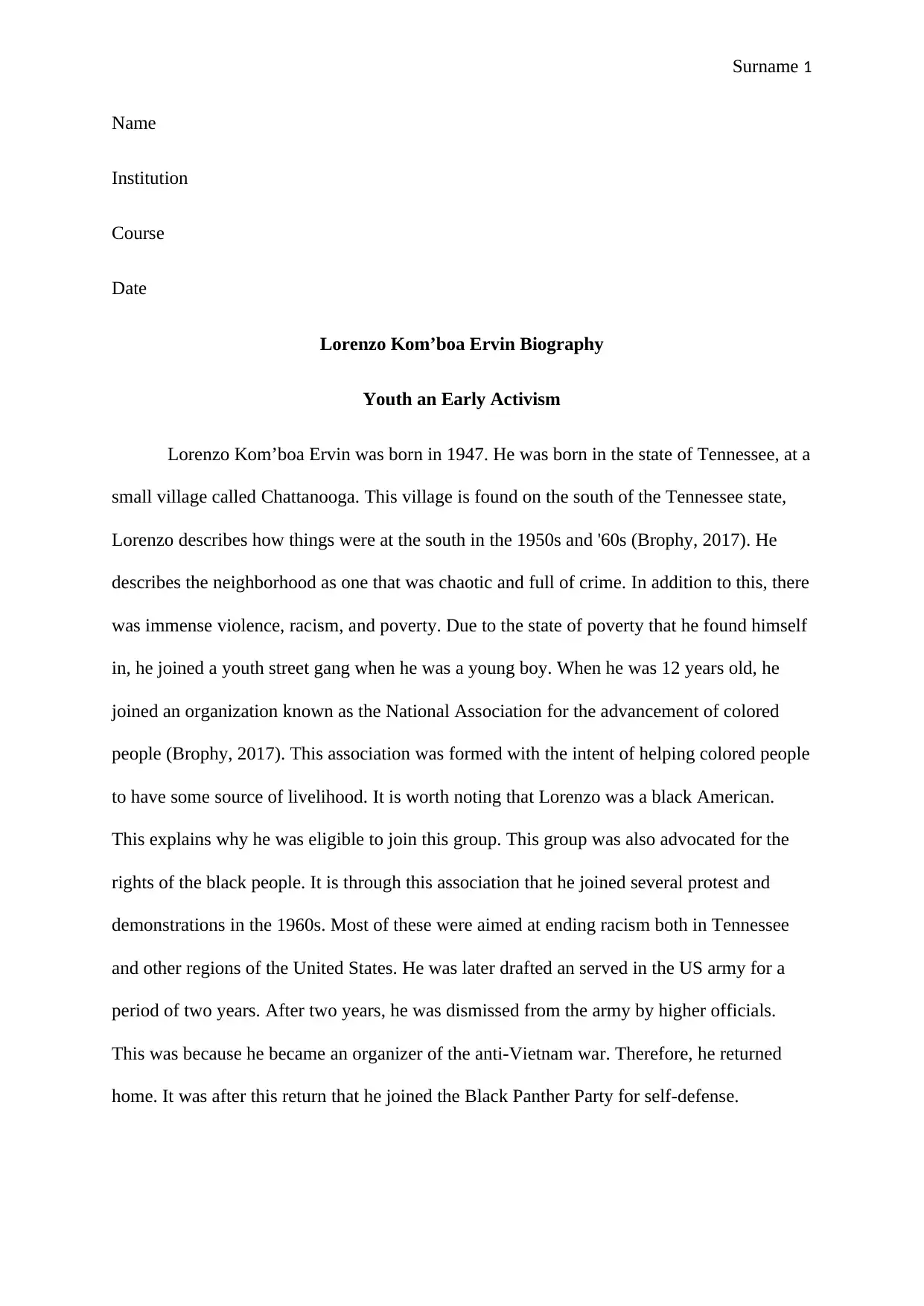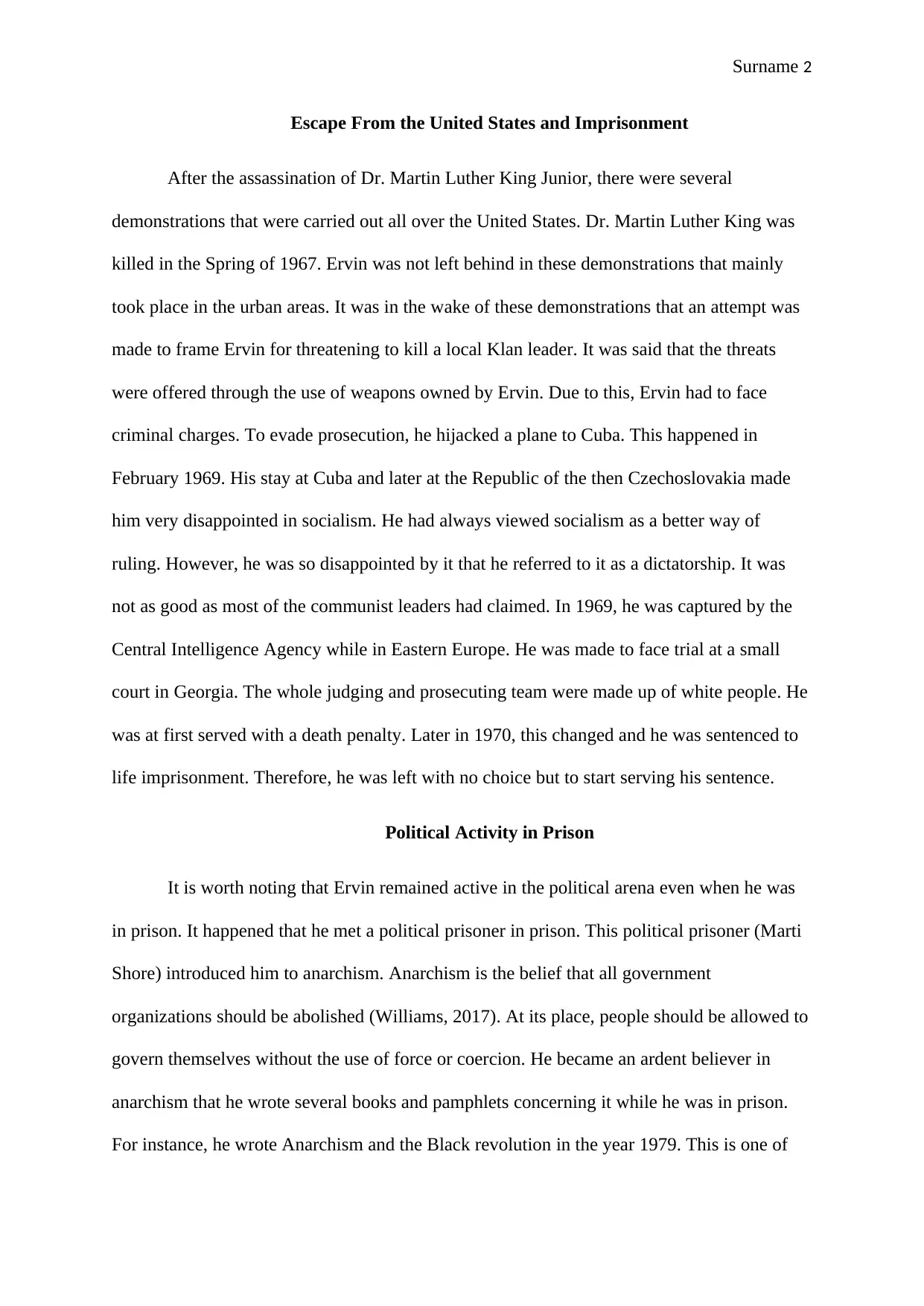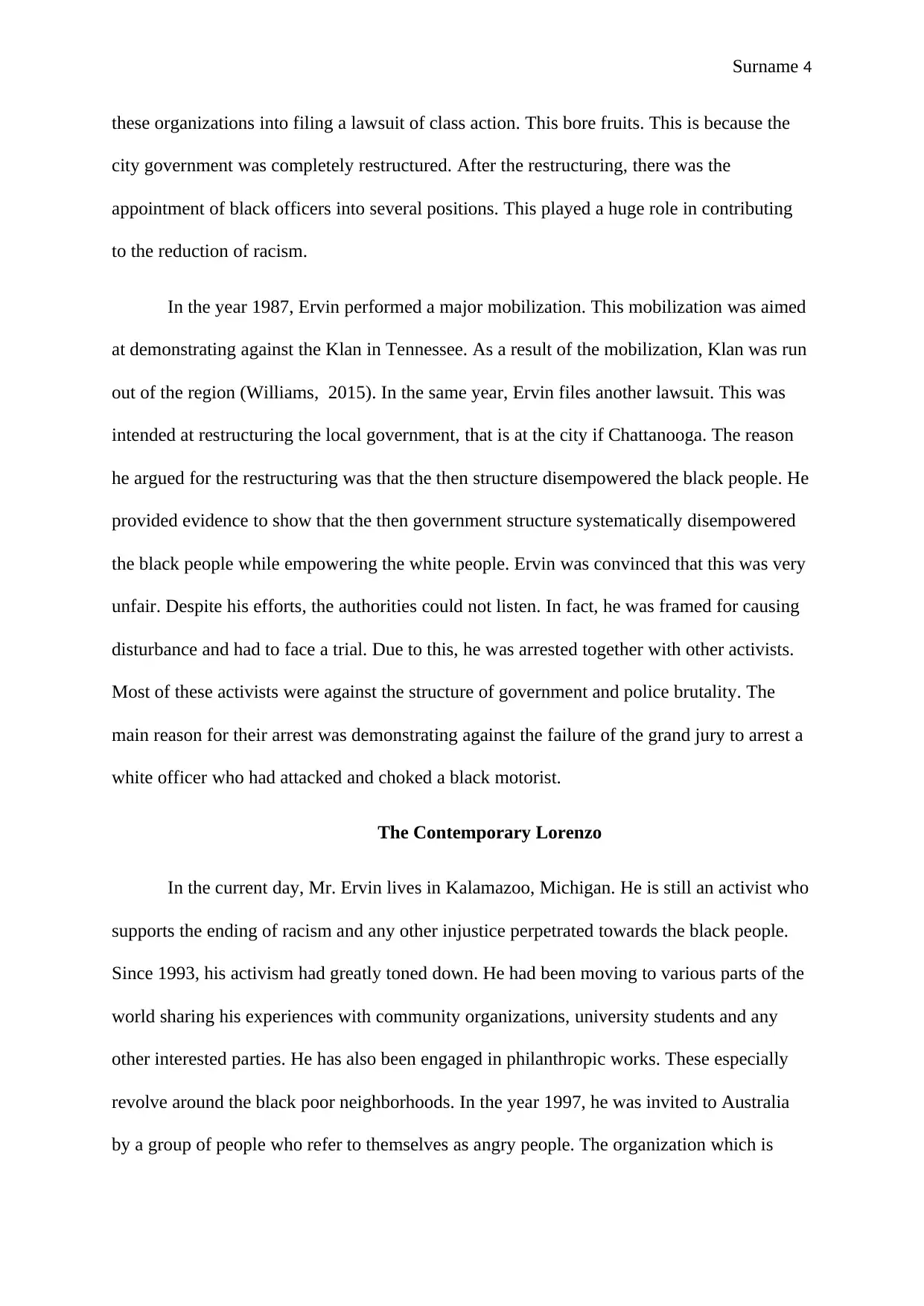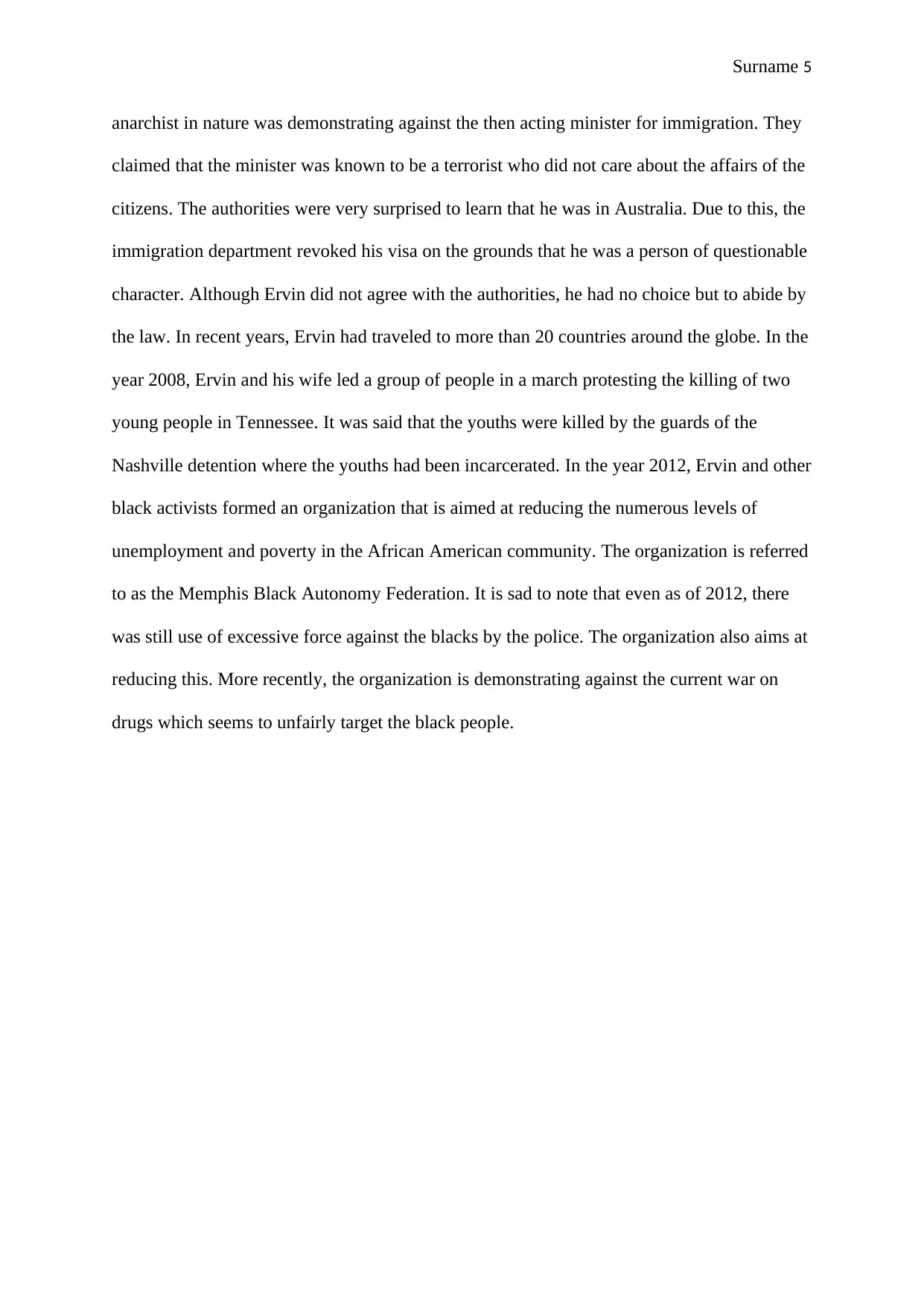The Life and Activism of Lorenzo Kom'boa Ervin: A Biographical Report
VerifiedAdded on 2023/01/17
|6
|1804
|20
Report
AI Summary
This report presents a biography of Lorenzo Kom'boa Ervin, tracing his life from his childhood in Chattanooga, Tennessee, to his contemporary activism. It details his early involvement with the NAACP and his subsequent engagement with the Black Panther Party, including his anti-war activities and subsequent flight to Cuba and imprisonment. The report explores his embrace of anarchism while in prison and his writings on the subject, as well as his post-release activism, including campaigns against police brutality and for government restructuring. The biography highlights his recent work with organizations focused on reducing unemployment and poverty in the African American community, his international travels, and his continued advocacy for social justice and against racism, providing a comprehensive overview of his political journey and lasting impact.

Surname 1
Name
Institution
Course
Date
Lorenzo Kom’boa Ervin Biography
Youth an Early Activism
Lorenzo Kom’boa Ervin was born in 1947. He was born in the state of Tennessee, at a
small village called Chattanooga. This village is found on the south of the Tennessee state,
Lorenzo describes how things were at the south in the 1950s and '60s (Brophy, 2017). He
describes the neighborhood as one that was chaotic and full of crime. In addition to this, there
was immense violence, racism, and poverty. Due to the state of poverty that he found himself
in, he joined a youth street gang when he was a young boy. When he was 12 years old, he
joined an organization known as the National Association for the advancement of colored
people (Brophy, 2017). This association was formed with the intent of helping colored people
to have some source of livelihood. It is worth noting that Lorenzo was a black American.
This explains why he was eligible to join this group. This group was also advocated for the
rights of the black people. It is through this association that he joined several protest and
demonstrations in the 1960s. Most of these were aimed at ending racism both in Tennessee
and other regions of the United States. He was later drafted an served in the US army for a
period of two years. After two years, he was dismissed from the army by higher officials.
This was because he became an organizer of the anti-Vietnam war. Therefore, he returned
home. It was after this return that he joined the Black Panther Party for self-defense.
Name
Institution
Course
Date
Lorenzo Kom’boa Ervin Biography
Youth an Early Activism
Lorenzo Kom’boa Ervin was born in 1947. He was born in the state of Tennessee, at a
small village called Chattanooga. This village is found on the south of the Tennessee state,
Lorenzo describes how things were at the south in the 1950s and '60s (Brophy, 2017). He
describes the neighborhood as one that was chaotic and full of crime. In addition to this, there
was immense violence, racism, and poverty. Due to the state of poverty that he found himself
in, he joined a youth street gang when he was a young boy. When he was 12 years old, he
joined an organization known as the National Association for the advancement of colored
people (Brophy, 2017). This association was formed with the intent of helping colored people
to have some source of livelihood. It is worth noting that Lorenzo was a black American.
This explains why he was eligible to join this group. This group was also advocated for the
rights of the black people. It is through this association that he joined several protest and
demonstrations in the 1960s. Most of these were aimed at ending racism both in Tennessee
and other regions of the United States. He was later drafted an served in the US army for a
period of two years. After two years, he was dismissed from the army by higher officials.
This was because he became an organizer of the anti-Vietnam war. Therefore, he returned
home. It was after this return that he joined the Black Panther Party for self-defense.
Paraphrase This Document
Need a fresh take? Get an instant paraphrase of this document with our AI Paraphraser

Surname 2
Escape From the United States and Imprisonment
After the assassination of Dr. Martin Luther King Junior, there were several
demonstrations that were carried out all over the United States. Dr. Martin Luther King was
killed in the Spring of 1967. Ervin was not left behind in these demonstrations that mainly
took place in the urban areas. It was in the wake of these demonstrations that an attempt was
made to frame Ervin for threatening to kill a local Klan leader. It was said that the threats
were offered through the use of weapons owned by Ervin. Due to this, Ervin had to face
criminal charges. To evade prosecution, he hijacked a plane to Cuba. This happened in
February 1969. His stay at Cuba and later at the Republic of the then Czechoslovakia made
him very disappointed in socialism. He had always viewed socialism as a better way of
ruling. However, he was so disappointed by it that he referred to it as a dictatorship. It was
not as good as most of the communist leaders had claimed. In 1969, he was captured by the
Central Intelligence Agency while in Eastern Europe. He was made to face trial at a small
court in Georgia. The whole judging and prosecuting team were made up of white people. He
was at first served with a death penalty. Later in 1970, this changed and he was sentenced to
life imprisonment. Therefore, he was left with no choice but to start serving his sentence.
Political Activity in Prison
It is worth noting that Ervin remained active in the political arena even when he was
in prison. It happened that he met a political prisoner in prison. This political prisoner (Marti
Shore) introduced him to anarchism. Anarchism is the belief that all government
organizations should be abolished (Williams, 2017). At its place, people should be allowed to
govern themselves without the use of force or coercion. He became an ardent believer in
anarchism that he wrote several books and pamphlets concerning it while he was in prison.
For instance, he wrote Anarchism and the Black revolution in the year 1979. This is one of
Escape From the United States and Imprisonment
After the assassination of Dr. Martin Luther King Junior, there were several
demonstrations that were carried out all over the United States. Dr. Martin Luther King was
killed in the Spring of 1967. Ervin was not left behind in these demonstrations that mainly
took place in the urban areas. It was in the wake of these demonstrations that an attempt was
made to frame Ervin for threatening to kill a local Klan leader. It was said that the threats
were offered through the use of weapons owned by Ervin. Due to this, Ervin had to face
criminal charges. To evade prosecution, he hijacked a plane to Cuba. This happened in
February 1969. His stay at Cuba and later at the Republic of the then Czechoslovakia made
him very disappointed in socialism. He had always viewed socialism as a better way of
ruling. However, he was so disappointed by it that he referred to it as a dictatorship. It was
not as good as most of the communist leaders had claimed. In 1969, he was captured by the
Central Intelligence Agency while in Eastern Europe. He was made to face trial at a small
court in Georgia. The whole judging and prosecuting team were made up of white people. He
was at first served with a death penalty. Later in 1970, this changed and he was sentenced to
life imprisonment. Therefore, he was left with no choice but to start serving his sentence.
Political Activity in Prison
It is worth noting that Ervin remained active in the political arena even when he was
in prison. It happened that he met a political prisoner in prison. This political prisoner (Marti
Shore) introduced him to anarchism. Anarchism is the belief that all government
organizations should be abolished (Williams, 2017). At its place, people should be allowed to
govern themselves without the use of force or coercion. He became an ardent believer in
anarchism that he wrote several books and pamphlets concerning it while he was in prison.
For instance, he wrote Anarchism and the Black revolution in the year 1979. This is one of

Surname 3
the most widely read books on anarchy. In fact, most anarch scholars borrow from the
anarchist theory that is outlined in the book. It is worth noting that the book is still popular
today and has gone through several editions. It seems as if the special engagement between
Ervin and the political prisoner changed his life completely. This is because he completely
adopted the ideas of anarchism. In addition to writing books and adopting the ideologies of
anarchism, Ervin was involved in many prison struggles. Although he did this, no one noted
his struggles because he was a prisoner. It was not until he struggled so much that he became
part of what was referred to as the Marion Brothels. It was after he became part of the Marion
Brothels that his case caught the attention of the public. His great struggle and the
intervention of the public led to his release. He was released after serving for a period of 15
years.
Life after Prison
Unlike most of the ex-prisoners who do not engage themselves in politics after release
from jail, Ervin became politically active soon after his release. He joined a local
organization that was involved in fighting for justice against police brutality. The
organization was based in his home village. It was through this local organization that he led
a 10-year campaign that advocated for justice. The campaign bore fruit for it resulted in the
resigning of the chief of police. In addition, the police commissioner also resigned. This was
a great step in the search for justice and the local organization had finally started bearing
some fruits. This came after the local organization had done numerous campaigns in several
regions of the United States. In addition, they had also filed many lawsuits seeking protection
from racist officers. At that time, there have been numerous killings of black people by racist
officers. In addition, the racist officer seemed to target the poor people and kill them even
when they had committed no crime. Later, Ervin became the president of this organization.
He influenced other black organizations to be united. After coming together, he led several of
the most widely read books on anarchy. In fact, most anarch scholars borrow from the
anarchist theory that is outlined in the book. It is worth noting that the book is still popular
today and has gone through several editions. It seems as if the special engagement between
Ervin and the political prisoner changed his life completely. This is because he completely
adopted the ideas of anarchism. In addition to writing books and adopting the ideologies of
anarchism, Ervin was involved in many prison struggles. Although he did this, no one noted
his struggles because he was a prisoner. It was not until he struggled so much that he became
part of what was referred to as the Marion Brothels. It was after he became part of the Marion
Brothels that his case caught the attention of the public. His great struggle and the
intervention of the public led to his release. He was released after serving for a period of 15
years.
Life after Prison
Unlike most of the ex-prisoners who do not engage themselves in politics after release
from jail, Ervin became politically active soon after his release. He joined a local
organization that was involved in fighting for justice against police brutality. The
organization was based in his home village. It was through this local organization that he led
a 10-year campaign that advocated for justice. The campaign bore fruit for it resulted in the
resigning of the chief of police. In addition, the police commissioner also resigned. This was
a great step in the search for justice and the local organization had finally started bearing
some fruits. This came after the local organization had done numerous campaigns in several
regions of the United States. In addition, they had also filed many lawsuits seeking protection
from racist officers. At that time, there have been numerous killings of black people by racist
officers. In addition, the racist officer seemed to target the poor people and kill them even
when they had committed no crime. Later, Ervin became the president of this organization.
He influenced other black organizations to be united. After coming together, he led several of
⊘ This is a preview!⊘
Do you want full access?
Subscribe today to unlock all pages.

Trusted by 1+ million students worldwide

Surname 4
these organizations into filing a lawsuit of class action. This bore fruits. This is because the
city government was completely restructured. After the restructuring, there was the
appointment of black officers into several positions. This played a huge role in contributing
to the reduction of racism.
In the year 1987, Ervin performed a major mobilization. This mobilization was aimed
at demonstrating against the Klan in Tennessee. As a result of the mobilization, Klan was run
out of the region (Williams, 2015). In the same year, Ervin files another lawsuit. This was
intended at restructuring the local government, that is at the city if Chattanooga. The reason
he argued for the restructuring was that the then structure disempowered the black people. He
provided evidence to show that the then government structure systematically disempowered
the black people while empowering the white people. Ervin was convinced that this was very
unfair. Despite his efforts, the authorities could not listen. In fact, he was framed for causing
disturbance and had to face a trial. Due to this, he was arrested together with other activists.
Most of these activists were against the structure of government and police brutality. The
main reason for their arrest was demonstrating against the failure of the grand jury to arrest a
white officer who had attacked and choked a black motorist.
The Contemporary Lorenzo
In the current day, Mr. Ervin lives in Kalamazoo, Michigan. He is still an activist who
supports the ending of racism and any other injustice perpetrated towards the black people.
Since 1993, his activism had greatly toned down. He had been moving to various parts of the
world sharing his experiences with community organizations, university students and any
other interested parties. He has also been engaged in philanthropic works. These especially
revolve around the black poor neighborhoods. In the year 1997, he was invited to Australia
by a group of people who refer to themselves as angry people. The organization which is
these organizations into filing a lawsuit of class action. This bore fruits. This is because the
city government was completely restructured. After the restructuring, there was the
appointment of black officers into several positions. This played a huge role in contributing
to the reduction of racism.
In the year 1987, Ervin performed a major mobilization. This mobilization was aimed
at demonstrating against the Klan in Tennessee. As a result of the mobilization, Klan was run
out of the region (Williams, 2015). In the same year, Ervin files another lawsuit. This was
intended at restructuring the local government, that is at the city if Chattanooga. The reason
he argued for the restructuring was that the then structure disempowered the black people. He
provided evidence to show that the then government structure systematically disempowered
the black people while empowering the white people. Ervin was convinced that this was very
unfair. Despite his efforts, the authorities could not listen. In fact, he was framed for causing
disturbance and had to face a trial. Due to this, he was arrested together with other activists.
Most of these activists were against the structure of government and police brutality. The
main reason for their arrest was demonstrating against the failure of the grand jury to arrest a
white officer who had attacked and choked a black motorist.
The Contemporary Lorenzo
In the current day, Mr. Ervin lives in Kalamazoo, Michigan. He is still an activist who
supports the ending of racism and any other injustice perpetrated towards the black people.
Since 1993, his activism had greatly toned down. He had been moving to various parts of the
world sharing his experiences with community organizations, university students and any
other interested parties. He has also been engaged in philanthropic works. These especially
revolve around the black poor neighborhoods. In the year 1997, he was invited to Australia
by a group of people who refer to themselves as angry people. The organization which is
Paraphrase This Document
Need a fresh take? Get an instant paraphrase of this document with our AI Paraphraser

Surname 5
anarchist in nature was demonstrating against the then acting minister for immigration. They
claimed that the minister was known to be a terrorist who did not care about the affairs of the
citizens. The authorities were very surprised to learn that he was in Australia. Due to this, the
immigration department revoked his visa on the grounds that he was a person of questionable
character. Although Ervin did not agree with the authorities, he had no choice but to abide by
the law. In recent years, Ervin had traveled to more than 20 countries around the globe. In the
year 2008, Ervin and his wife led a group of people in a march protesting the killing of two
young people in Tennessee. It was said that the youths were killed by the guards of the
Nashville detention where the youths had been incarcerated. In the year 2012, Ervin and other
black activists formed an organization that is aimed at reducing the numerous levels of
unemployment and poverty in the African American community. The organization is referred
to as the Memphis Black Autonomy Federation. It is sad to note that even as of 2012, there
was still use of excessive force against the blacks by the police. The organization also aims at
reducing this. More recently, the organization is demonstrating against the current war on
drugs which seems to unfairly target the black people.
anarchist in nature was demonstrating against the then acting minister for immigration. They
claimed that the minister was known to be a terrorist who did not care about the affairs of the
citizens. The authorities were very surprised to learn that he was in Australia. Due to this, the
immigration department revoked his visa on the grounds that he was a person of questionable
character. Although Ervin did not agree with the authorities, he had no choice but to abide by
the law. In recent years, Ervin had traveled to more than 20 countries around the globe. In the
year 2008, Ervin and his wife led a group of people in a march protesting the killing of two
young people in Tennessee. It was said that the youths were killed by the guards of the
Nashville detention where the youths had been incarcerated. In the year 2012, Ervin and other
black activists formed an organization that is aimed at reducing the numerous levels of
unemployment and poverty in the African American community. The organization is referred
to as the Memphis Black Autonomy Federation. It is sad to note that even as of 2012, there
was still use of excessive force against the blacks by the police. The organization also aims at
reducing this. More recently, the organization is demonstrating against the current war on
drugs which seems to unfairly target the black people.

Surname 6
References
Brophy, A. L. (2017). Black Power in a Prison Library. Howard LJ, 61, 1.
Williams, D. (2017). From BlackLivesMatter to Black Liberation. Anarchist Studies, 25(2),
122-124.
Williams, D. M. (2015). Black Panther radical fractionalization and the development of Black
anarchism. Journal of Black Studies, 46(7), 678-703.
References
Brophy, A. L. (2017). Black Power in a Prison Library. Howard LJ, 61, 1.
Williams, D. (2017). From BlackLivesMatter to Black Liberation. Anarchist Studies, 25(2),
122-124.
Williams, D. M. (2015). Black Panther radical fractionalization and the development of Black
anarchism. Journal of Black Studies, 46(7), 678-703.
⊘ This is a preview!⊘
Do you want full access?
Subscribe today to unlock all pages.

Trusted by 1+ million students worldwide
1 out of 6
Your All-in-One AI-Powered Toolkit for Academic Success.
+13062052269
info@desklib.com
Available 24*7 on WhatsApp / Email
![[object Object]](/_next/static/media/star-bottom.7253800d.svg)
Unlock your academic potential
Copyright © 2020–2025 A2Z Services. All Rights Reserved. Developed and managed by ZUCOL.